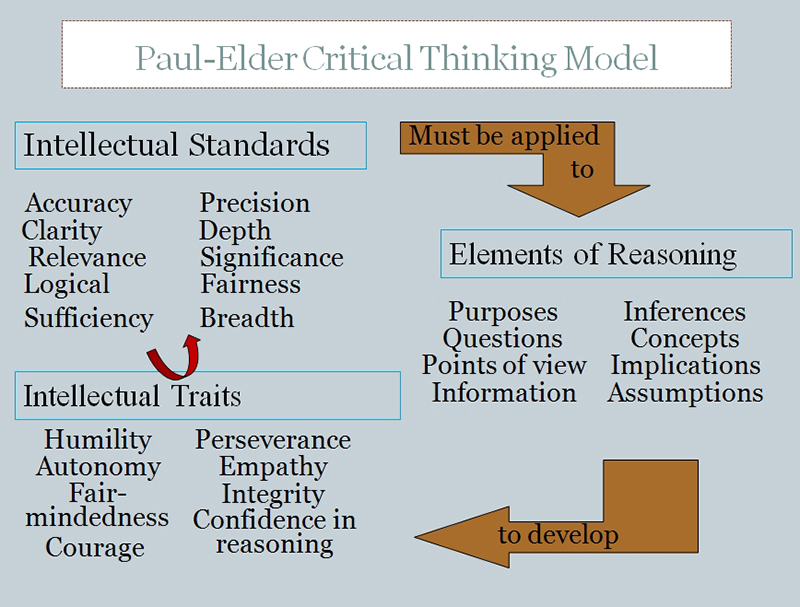Paul-Elder Critical Thinking Framework
Critical thinking is that mode of thinking – about any subject, content, or problem — in which the thinker improves the quality of his or her thinking by skillfully taking charge of the structures inherent in thinking and imposing intellectual standards upon them. (Paul and Elder, 2001). The Paul-Elder framework has three components:
- The elements of thought (reasoning)
- The intellectual standards that should be applied to the elements of reasoning
- The intellectual traits associated with a cultivated critical thinker that result from the consistent and disciplined application of the intellectual standards to the elements of thought

According to Paul and Elder (1997), there are two essential dimensions of thinking that students need to master in order to learn how to upgrade their thinking. They need to be able to identify the "parts" of their thinking, and they need to be able to assess their use of these parts of thinking.
Elements of Thought (reasoning)
The "parts" or elements of thinking are as follows:
- All reasoning has a purpose
- All reasoning is an attempt to figure something out, to settle some question, to solve some problem
- All reasoning is based on assumptions
- All reasoning is done from some point of view
- All reasoning is based on data, information and evidence
- All reasoning is expressed through, and shaped by, concepts and ideas
- All reasoning contains inferences or interpretations by which we draw conclusions and give meaning to data
- All reasoning leads somewhere or has implications and consequences
Universal Intellectual Standards
The intellectual standards that are to these elements are used to determine the quality of reasoning. Good critical thinking requires having a command of these standards. According to Paul and Elder (1997 ,2006), the ultimate goal is for the standards of reasoning to become infused in all thinking so as to become the guide to better and better reasoning. The intellectual standards include:
- Clarity
- Could you elaborate?
- Could you illustrate what you mean?
- Could you give me an example?
- Accuracy
- How could we check on that?
- How could we find out if that is true?
- How could we verify or test that?
- Precision
- Could you be more specific?
- Could you give me more details?
- Could you be more exact?
- Relevance
- How does that relate to the problem?
- How does that bear on the question?
- How does that help us with the issue?
- Depth
- What factors make this difficult?
- What are some of the complexities of this question?
- What are some of the difficulties we need to deal with?
- Breadth
- Do we need to look at this from another perspective?
- Do we need to consider another point of view?
- Do we need to look at this in other ways?
- Logic
- Does all of this make sense together?
- Does your first paragraph fit in with your last one?
- Does what you say follow from the evidence?
- Significance
- Is this the most important problem to consider?
- Is this the central idea to focus on?
- Which of these facts are most important?
- Fairness
- Is my thinking justifiable in context?
- Am I taking into account the thinking of others?
- Is my purpose fair given the situation?
- Am I using my concepts in keeping with educated usage, or am I distorting them to get what I want?
Intellectual Traits
Consistent application of the standards of thinking to the elements of thinking result in the development of intellectual traits of:
- Intellectual Humility
- Intellectual Courage
- Intellectual Empathy
- Intellectual Autonomy
- Intellectual Integrity
- Intellectual Perseverance
- Confidence in Reason
- Fair-mindedness
Characteristics of a Well-Cultivated Critical Thinker
Habitual utilization of the intellectual traits produce a well-cultivated critical thinker who is able to:
- Raise vital questions and problems, formulating them clearly and precisely
- Gather and assess relevant information, using abstract ideas to interpret it effectively
- Come to well-reasoned conclusions and solutions, testing them against relevant criteria and standards;
- Think open-mindedly within alternative systems of thought, recognizing and assessing, as need be, their assumptions, implications, and practical consequences; and
- Communicate effectively with others in figuring out solutions to complex problems
Paul, R. and Elder, L. (2010). The Miniature Guide to Critical Thinking Concepts and Tools. Dillon Beach: Foundation for Critical Thinking Press.
